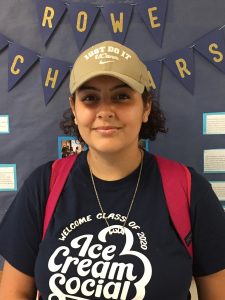 Hanya Ouda was born in Cairo, Egypt but currently lives in Coventry, CT. She’s a graduate of Connecticut International Baccalaureate Academy in East Hartford, CT. Hanya is a chemistry major on the pre-med track and has had the opportunity to shadow at a hospital for two years, once with the High School Student Research Apprentice Program and once with her pediatrician. These experiences exposed her to different fields in medicine as well as the importance of patient care.
Hanya Ouda was born in Cairo, Egypt but currently lives in Coventry, CT. She’s a graduate of Connecticut International Baccalaureate Academy in East Hartford, CT. Hanya is a chemistry major on the pre-med track and has had the opportunity to shadow at a hospital for two years, once with the High School Student Research Apprentice Program and once with her pediatrician. These experiences exposed her to different fields in medicine as well as the importance of patient care.
Rowe
2018 Rowe Scholar: Neco McFadden
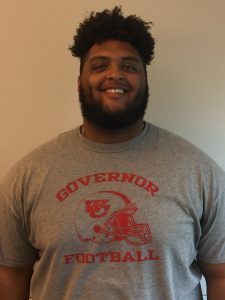 Neco McFadden is from New Haven, CT and graduated from Wilbur Cross High School. His interests lie in athletic training and nutrition. He’s inspired by his high school athletic trainer and is eager to start learning more about the human body. Neco is a good strength trainer and someday wants to compete. He also sees himself potentially becoming a strength coach.
Neco McFadden is from New Haven, CT and graduated from Wilbur Cross High School. His interests lie in athletic training and nutrition. He’s inspired by his high school athletic trainer and is eager to start learning more about the human body. Neco is a good strength trainer and someday wants to compete. He also sees himself potentially becoming a strength coach.
2018 Rowe Scholar: Camila Martinez
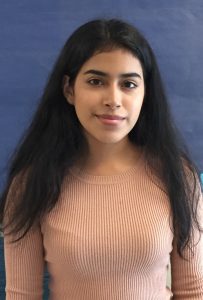 Irma “Camila” Martinez is an award-winning artist who enjoys taking art classes as a way to find balance in her schedule. She’ll be a molecular and cell biology major on the pre-med track at UConn, and hopes to get involved in research and clinical work. In high school she was a member of the medical club, which allowed her to learn about different medical roles, technology, and education. One of the club’s notable speakers was a cardiologist whose enthusiasm made her appreciate those who work in the medical field. Irma also found it to be an incredibly rewarding experience to shadow her aunt, an oral surgeon. Originally from Lima, Peru, Irma now lives in West Hartford, CT and graduated from Hall High School.
Irma “Camila” Martinez is an award-winning artist who enjoys taking art classes as a way to find balance in her schedule. She’ll be a molecular and cell biology major on the pre-med track at UConn, and hopes to get involved in research and clinical work. In high school she was a member of the medical club, which allowed her to learn about different medical roles, technology, and education. One of the club’s notable speakers was a cardiologist whose enthusiasm made her appreciate those who work in the medical field. Irma also found it to be an incredibly rewarding experience to shadow her aunt, an oral surgeon. Originally from Lima, Peru, Irma now lives in West Hartford, CT and graduated from Hall High School.
2018 Rowe Scholar: Andrew Hungerford
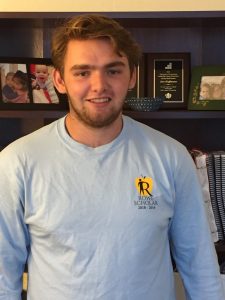 Andrew Hungerford is a biological sciences major with a particular interest in the nervous system. He has shadowed a surgeon at the Hospital of Central Connecticut, where he was able to see surgeries in person. A native of West Hartford, CT, Andrew graduated from Northwest Catholic. He loves to solve Rubik’s Cubes and the many variations that have come out since the original.
Andrew Hungerford is a biological sciences major with a particular interest in the nervous system. He has shadowed a surgeon at the Hospital of Central Connecticut, where he was able to see surgeries in person. A native of West Hartford, CT, Andrew graduated from Northwest Catholic. He loves to solve Rubik’s Cubes and the many variations that have come out since the original.
2018 Rowe Scholar: Ashlie Delskey
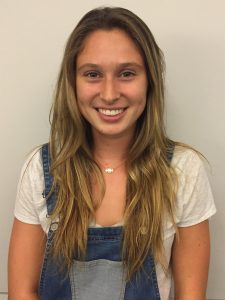 Ashlie Delskey hails from Somers, CT where she graduated from Somers High School. She enjoys running and playing lacrosse. A nursing major, she’s been inspired by her experiences shadowing a nurse practitioner and PA, who she says remained calm and friendly despite their high patient volume. She has also spent years watching her cousin’s pediatric team take care of him at Boston Children’s Hospital, and she notes that they’ve always been patient and kind.
Ashlie Delskey hails from Somers, CT where she graduated from Somers High School. She enjoys running and playing lacrosse. A nursing major, she’s been inspired by her experiences shadowing a nurse practitioner and PA, who she says remained calm and friendly despite their high patient volume. She has also spent years watching her cousin’s pediatric team take care of him at Boston Children’s Hospital, and she notes that they’ve always been patient and kind.
2018 Rowe Scholar: Erika deAndrade
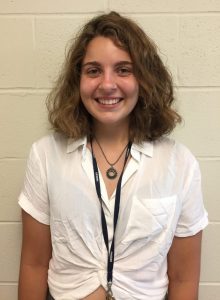 Erika deAndrade recently spent a summer gaining a great deal of experience with the Veterans Affairs (VA) system. At the Atlanta VA she shadowed and assisted different medical personnel, while at the Fayetteville VA she worked on the psych ward, taking notes, observing, and assisting mentally unstable veterans. At the VA Compensation Evaluation Center she observed and assisted with the documentation of veterans’ conditions post-service. Erika is from Ledyard, CT and graduated from Ledyard High School. She has a strong interest in science because she believes it helps us understand the world around us and that it’ll continue to be a pivotal subject of study in the future. She’s also very interested in the visual arts and ceramics. Another of Erika’s hobbies is travel and experiencing other cultures, which is made easier by the fact that her father’s a pilot and she flies for free.
Erika deAndrade recently spent a summer gaining a great deal of experience with the Veterans Affairs (VA) system. At the Atlanta VA she shadowed and assisted different medical personnel, while at the Fayetteville VA she worked on the psych ward, taking notes, observing, and assisting mentally unstable veterans. At the VA Compensation Evaluation Center she observed and assisted with the documentation of veterans’ conditions post-service. Erika is from Ledyard, CT and graduated from Ledyard High School. She has a strong interest in science because she believes it helps us understand the world around us and that it’ll continue to be a pivotal subject of study in the future. She’s also very interested in the visual arts and ceramics. Another of Erika’s hobbies is travel and experiencing other cultures, which is made easier by the fact that her father’s a pilot and she flies for free.
2018 Rowe Scholar: Paulo Belato
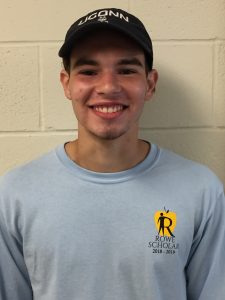 Paulo Belato is a soccer fanatic. He loves playing it and cheering on his favorite team, Tottenham Hotspur FC. He was lucky enough to be given a trip to England and France as a graduation gift, and watched professional games in each country. Paulo also enjoys the study of biology and chemistry, which he believes are the foundation of modern medicine. He has shadowed nurses at Danbury Hospital, a pharmacist at Woodbury Drug Store, and a physician at Black Rock Pediatrics. He learned that health care providers need to be genuine to make their patients feel comfortable and safe, that there is a reason behind everything, and that one must do what one loves in order to be satisfied at the end of the day. Paulo graduated from Bethel High School in Bethel, CT, where he has lived since the age of four. Both his parents were born in Brazil, so the Brazilian culture has a big influence on who he is and his interests.
Paulo Belato is a soccer fanatic. He loves playing it and cheering on his favorite team, Tottenham Hotspur FC. He was lucky enough to be given a trip to England and France as a graduation gift, and watched professional games in each country. Paulo also enjoys the study of biology and chemistry, which he believes are the foundation of modern medicine. He has shadowed nurses at Danbury Hospital, a pharmacist at Woodbury Drug Store, and a physician at Black Rock Pediatrics. He learned that health care providers need to be genuine to make their patients feel comfortable and safe, that there is a reason behind everything, and that one must do what one loves in order to be satisfied at the end of the day. Paulo graduated from Bethel High School in Bethel, CT, where he has lived since the age of four. Both his parents were born in Brazil, so the Brazilian culture has a big influence on who he is and his interests.
Rowe Researcher: Rat Models and Human Hearing
Rat Models and Human Hearing: The Categorical Perception of Species-Specific Rate Vocalization
Spring 2018
Principle Investigator: Heather Read
Contributors: Sharon Cherian, Caitlyn Cody, Mackenzie Zapata, Timothy Nolan, Peter Satonick
Several studies have shown that humans and rats are able to differentiate timing cues in sound sequences. The importance of timing cues for speech and word recognition in normal hearing of adults has been recognized by Shannon (1995) and Souza (2015) who outlined the significance of timing cues for speech recognition among the aging human population, that commonly encounter tone frequency hearing loss. Rats are able to communicate and recognize non-speech vocalizations, as do humans.
We will use the two-alternative forced choice (2AFC) task to train rats to discriminate vocalizations (Gaese et al., 2006; Zarillow and Zador, 2014). The rats will be placed in a sound proof training booth that have nose poke ports on the inside. In the first stage (early stage) of the task, the rats will be receiving a “direct reward” for learning to associate one vocalization with sound delivery with a reward from a port located on the right, and another with sound delivery and reward from a port on the left. First rats are trained incrementally to hold in the Central Nose Port for 150-600 milliseconds to initiate their trial. After holding and hearing the sound play for this duration, the rat needs to navigate to the correct port to receive their reward. The reward is in the form of strawberry or chocolate Ensure protein solution. Once the performance criterion reaches 70-100% for discriminating, the rats will be switched to the “Indirect” phase for the 2AFC paradigm. The sounds in this stage will all be delivered from a central speaker, removing the location cue indicating where the reward might be. Once the rats reach 70-100% correct for the “indirect phase,” they can now be tested in the 2AFC task for discrimination of sound sequences that vary in: timing cues only or timing plus tonal cues combined together.
My research project is essential to understanding more about the auditory system through the examination of interactions between tonal and timing perceptual cues. The results from this research project will allow us to have a more in-depth understanding about not only the auditory system, but how humans perceive specific vocalization sequences and discrimination abilities. Using these results, this will be able to provide valuable insight about human hearing and aging. Hearing aids are widely used by the elderly population, so the results will allow us to optimize hearing aids, as humans do rely heavily on temporal cues to speech. Thus, these results will not only add more to our general understanding about the auditory system, but also allow for improvement for hearing aid devices and other related advancements in clinical settings.
2017 Rowe Scholar: Tonya Tucker
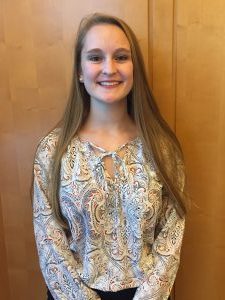
An avid volleyball player, Tonya Tucker is a biological sciences major from Newtown, CT, where she graduated from Newtown High School. Tonya’s experiences in healthcare have shaped the vision she has for her future. Volunteering at a free medical clinic has exposed her to issues in caring for the underserved, which is something she’d like to incorporate into her career, while shadowing at UConn Health’s OB/GYN department has sparked her interest in women’s health. Perhaps her most enjoyable health-related experience has been volunteering at a nursing home where she does art therapy with the residents, as art is one of her interests.
2017 Rowe Scholar: Julie Taing
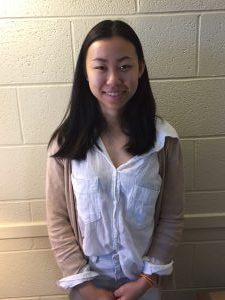
Julie Taing is a graduate of New Britain High School, which offered her the opportunity to become a CNA her senior year. She did her clinicals at hospitals and nursing homes and says that this was an eye-opening experience for her. Before that she had volunteered for two years at the Hospital for Special Care in the Close Observation Unit. She currently works as a CNA in a nursing home, which she says has given her an appreciation of those who work in the health field. Julie is from New Britain, CT and is part of a Cambodian dance troupe that performs Khmer classical ballet and folk dances all over the state. At UConn she’s a chemistry major on the pre-med track.